What is noteworthy about this bill is the expansion of language to encourage the development of all new technologies relating to clean energy. In RI we need updates to promote lots of good alternative sources of energy and commerce, such as EV's and their ability to not only drive clean, but deliver KW's back into the grid while sitting.
Here's part of the story...the link is: http://news.thomasnet.com/green_clean/2012/12/28/congress-manages-to-pass-a-small-energy-bill-that-pleases-nearly-everyone/
"While no one has been able to accuse Congress of being particularly functional lately, a tiny piece of energy-related legislation slipped through largely unnoticed last month. On Dec. 11, 2012, the House of Representatives passed the American Energy Manufacturing Technical Corrections Act (HR 6582) on a suspension vote of 398 to 2. The Senate approved the bill unanimously two days later, and President Obama signed it into law on Dec. 18.
So what sort of energy legislation passes through Congress nearly unanimously nowadays? The answer is, “minimally important legislation.”
H.R. 6582 corrects and adjusts existing energy laws — most specifically, some elements of the Energy Independence and Security Act of 2007 — to ensure that newer technologies that meet or exceed federal energy efficiency standards are not excluded simply because they are not covered by the 2007 law. The new bill largely covers appliances such as water heaters, commercial refrigerators, and some heating, ventilation and air conditioning (HVAC) units, including heat pumps. It essentially provides manufacturers with more flexibility in how they meet efficiency standards with these appliances, allowing leeway for some newer processes and materials that, despite being energy efficient, were different enough that they weren’t covered by existing law.
Some of the bill’s corrections include updating the uniform efficiency descriptor for covered water heaters, clarifying language regarding regulatory treatment for small-duct, high-velocity systems made by U.S.-based manufacturers, and establishing a separate, less stringent standard for over-the-counter commercial refrigerators which often have large glass windows, making them inherently less energy efficient than other commercial refrigerators.
The legislation also makes new provisions to more aggressively promote energy efficiency and support deployment of existing manufacturing technologies, and requires the U.S. Department of Energy (DoE) to take some small action on manufacturing efficiency, including clarification of periodic review of commercial equipment standards and how the agency responds to petitions regarding standards..."
We look forward to sharing a good 2013 with you. Thanks so much for your interest and support.

















